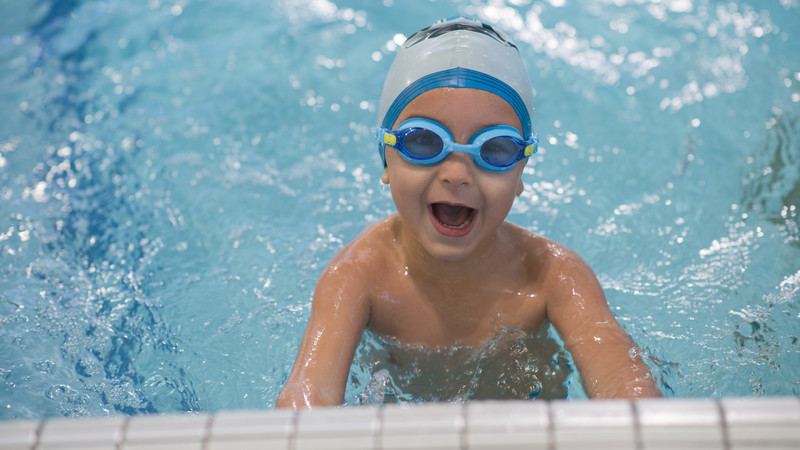




Family Health
Swimming Safety: The 5 Tips That Could Save Your Child's Life
Published: July 8, 2020After birth defects, drowning is the No. 1 cause of death for children ages 1 to 4. It can happen quickly, with less favorable outcomes associated with submersions of longer than five minutes.
I don’t share these statistics to scare parents but in hopes of creating proactive parents. Drowning is preventable. But it takes multiple layers of safety – five to be exact.

Multilayered Safety Plan for Young Swimmers
1. Four-sided pool fencing
Have a pool? Get a fence. Make sure it:
- Has four sides
- Is at least 4 feet high
- Has self-closing and self-latching gates
Whether the pool is above ground or underground, it should have a fence. This includes inflatable pools - something many families are investing in right now. Even though these types of pools are often exempt from local pool fencing requirements, they really should be surrounded by a fence just like permanent pools.
Research shows that a fence serving as a barrier around all sides of a pool can reduce a child’s risk of drowning by over 80 percent, compared to fencing that goes around only three sides of a pool.
2. Life Jackets
This doesn’t mean floaties, noodles or inflatable arm bands. Small children and nonswimmers should wear a U.S. Coast Guard-approved life jacket when they’re near water and when they’re swimming.
There are many types of life jackets, and knowing which one is best for your child can be difficult.
Type 1 jackets offer the most protection. They are the bulkiest, and they're meant for use in large bodies of water. They have the most buoyancy and can turn a child face up, but they can also be uncomfortable to wear for long periods of time.
Type 2 jackets come in more sizes for children and are less bulky. Some may turn a child face up in the water, but not as well as type 1 jackets.
Type 3 jackets are most comfortable, and they're meant for use in water sports or when they child is in the water for a short time. Many but not all type 3 jackets can turn a person face up.
Ultimately, it's up to parents to decide how much protection/buoyancy they want and how much confidence they have in their child's ability to swim.
Adults should wear life jackets when they’re boating to model safe behavior and make it easier to help in an emergency.
3. Swim Lessons
The appropriate age for swim lessons depends on the developmental abilities of the child, but some studies have shown that formal swim lessons may reduce the risk of drowning in children over the age of 1.
While the American Academy of Pediatrics (AAP) states that there is no evidence of swim lessons or water survival courses preventing drowning in children younger than 1, my recommendation is this: Go ahead and invest in swim lessons if you plan to have your baby around water.
Keep in mind: Swim lessons will not “drown proof” a child.
4. Supervision
Children should never be unsupervised, but especially near a pool or lake. No matter the event or gathering, it’s critical that the supervising adult is:
- Sober
- Within arm’s length
- Able to perform CPR
- Not distracted
At parties or large gatherings, take turns with other responsible adults serving as the designated water watcher.
5. Lifeguards
Drowning isn’t always so easy to spot. Children are rarely able to call for help or wave their arms when they are struggling in the water. Having a trained eye present – and someone who knows how to respond to medical emergencies – is always a good idea.
Having a lifeguard present should not make parents less vigilant. Again, the best strategy to prevent drowning is one that includes multiple interventions.
In the Event of an Emergency …
It’s always best to be prepared. Next time your kiddos want to go swimming, remember these five tips and take a look around. Is there rescue equipment nearby in case you need it? Some useful safety accessories include:
- Life jackets
- Buoys
- A shepherd’s crook (a long pole with a hook at the end)
In the case that an accident does occur, take control. Stay calm and focused. Ask someone to call 911 and start cardiopulmonary resuscitation (CPR) immediately. If alone, perform CPR for two minutes, then call 911.
Even if the child is unresponsive, never assume your efforts have no value. Continue CPR until medical professionals arrive.
Again, don’t let these tips scare you. Use them and refer to them often. At Methodist, we believe in arming parents with the information they need to keep their family healthy and safe. If you have any other questions regarding swimming safety, don’t hesitate to contact your Methodist pediatrician.
More Resources
- Review a step-by-step guide for CPR or find a class
- Check the Methodist Health System Calendar for an infant CPR class
- Keep your children safe from the sun and test your sunscreen IQ

